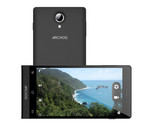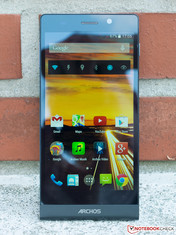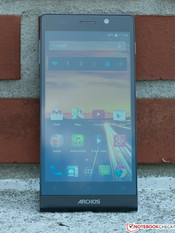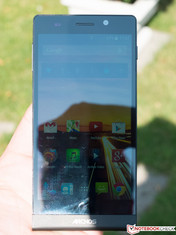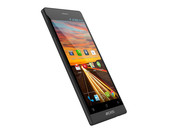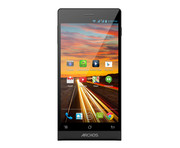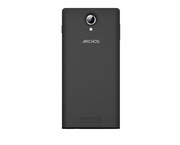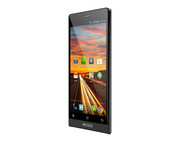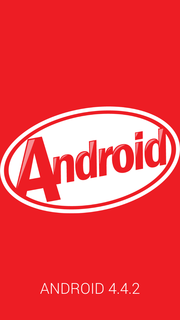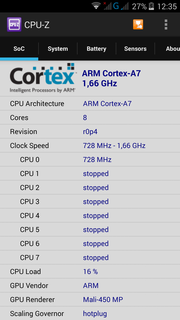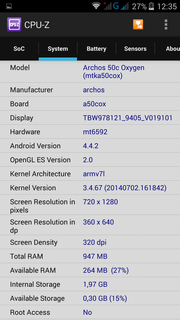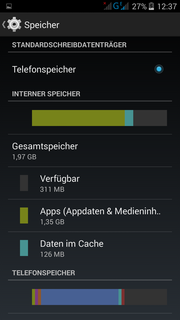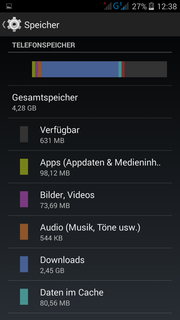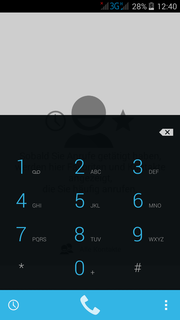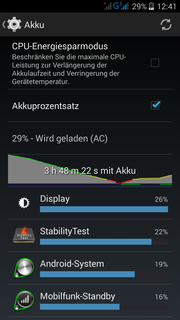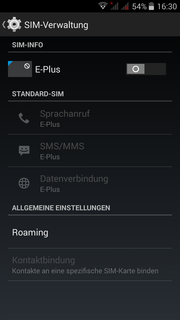Archos 50c Oxygen Smartphone Review
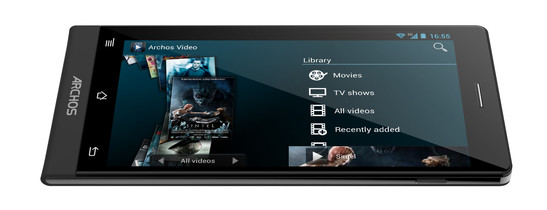
For the original German review, see here.
As can be seen based on the good test results of contenders like Motorola's Moto G, smartphones from the 200 Euro (~$268) range are slowly emerging from their grubby corner, and are developing to serious alternatives for buyers with medium to high demands. Users who do not need one of the present, high-speed SoCs, innovative features, extra software, a Full HD screen (or an even higher resolution), will often find everything that they want here. An example of this pleasing trend is our Archos 50c Oxygen. Its 5-inch HD screen (IPS, 1280 x 720 pixels, 294 ppi), Mediatek MT6592 octa-core SoC, and integrated Mali-450 MP4 GPU even stands out in this price range, where 960 x 540 pixels and slower dual or quad-core SoCs, such as the popular Qualcomm Snapdragon 400 MSM8926 / MSM8922 with integrated Adreno 305 are still often found. An 8 MP primary camera is not a matter of course in this price range either. A real highlight of our review sample is the option of inserting two SIM cards simultaneously (dual-SIM). Android 4.2.2 is the operating system used for all models currently in the market. We were lucky enough to have 4.4 KitKat preloaded on our review sample, which has (yet) only undergone very few modifications compared with Vanilla Android.
We selected a few phones based on the aforementioned Snapdragon SoC for comparison in our benchmarks: Sony's Xperia M2 (4.8 inches, approx. 250 Euros (~$335)), Motorola's Moto G (4.5 inches, approx. 170 Euros (~$228)), and Huawei's Ascend G6 (4.5 inches, approx. 250 Euros (~$335)). The 5.5-inch Huawei Ascend G730 that sports a slower Mediatek MT6582 (four cores, 1.3 GHz, Mali-400 MP2) is also in the race.
Case
The plastic casing is black (screen bezel) and dark charcoal gray. When looking at the phone from the front, it is noticed that both short sides are rounded in contrast to the long ones. It is the exact opposite when looking at the back. That looks stylish, but has the disadvantage that both lower corners are pressed into the hand when holding the device. However, that was only slightly annoying in practical use. The back's velvety soft, slip-resistant surface attracts fingerprints. The overall rigid casing can be warped marginally with a bit of effort, but does not produce noises. A quiet crackling is heard when pressing around on the easy-to-remove back.
Connectivity
The only two ports are found where they are usually expected: The micro-USB 2.0 port is on the lower right edge, the compulsory 3.5 mm jack is on the upper edge, slightly left from the center. Both SIM slots (1x mini, 1x micro) and the micro-SD slot for cards with up to 64 GB can be accessed easily after removing the back.
Software
The preloaded Android 4.4.2 on our review sample has barely been modified compared with the Vanilla Android on, for example, the Nexus smartphones from Google / LG. Users who highly value the additional and partly performance-devouring extra features, such as known from Samsung's TouchWiz user interface or HTC' Sense, will not be satisfied. Archos installs a few apps that we listed on the right. The manufacturer has announced an update to Android 4.4 KitKat for the fall.
Communication & GPS
The GPS quality was reliable when playing the augmented reality game Ingress. Satellites were found just as fast as with a Nexus 4 both outdoors and in rooms with a window. The accuracy was also compelling.
Telephony & Speech Quality
The included phone app only provides the most necessary features, such as call lists, hands-free, and microphone mute, and uses Google's contact app. Numbers from contacts can at least be found using a matchcode search via the letters of the keypad.
The in-call voice quality in the German E-Plus net is acceptable, but not overwhelming. The called person is very well intelligible, the voice sounds rich though a bit too prominent, sometimes slightly tinny, and marginally distorted. A landline contact reported a similar audio impression, and preferred the more restrained balance of a Nexus 4 microphone in a direct comparison. The decent volume cannot be criticized.
Cameras & Multimedia
Eight million pixels in a smartphone of this price range is awesome, at least on paper. However, it does not say much about the real picture quality. We noticed a tendency toward overexposed pictures in "normal" mode in practical use. The aggressive noise suppression does not quite manage to cancel out image noise in mono-colored surfaces, such as a blue sky, even in very good light conditions, and completely blurs low-contrast surfaces like a lawn. The contrast range that the camera can display is satisfactory.
Accessories
In addition to the power supply with an output of one ampere and a one-meter long USB cord, there is also a stereo headset and a tiny, multilingual user guide, as well as a small booklet with warranty and safety notes in the box.
Warranty
Besides the limited two-year retailer's warranty, Archos includes its own warranty for the same period. Details can be found here.
Input Devices & Controls
The capacitive touchscreen proves to be accurate, up into the outermost edges and corners, and free from lags. It can detect up to a maximum of five fingers at the same time. Three well responding sensor buttons are under the screen. It is difficult to see them when unlit. However, their use is easy when the position has been memorized.
A proprietary keyboard app is not installed, and the user has to rely on the stock Google keyboard. Although it is clearly arranged, it does not provide many features and does not even include a smiley button. The adaptive word completion is preloaded, but the dictionary is unfortunately saved locally.
Display
The resolution of the glossy, 5-inch IPS screen is 1280 x 720 pixels, which results in an ample dot density of 294 dpi. That is considerably more than a healthy human eye can distinguish from a distance of 45 cm (~17.7 inches).
The average maximum brightness (center) of all smartphones tested in the past eight months is 408 cd/m². Archos' phone is brighter with 426 cd/m², and places itself in the upper midfield. The illumination of 90% is also just above average.
| |||||||||||||||||||||||||
Brightness Distribution: 90 %
Center on Battery: 426 cd/m²
Contrast: 418:1 (Black: 1.02 cd/m²)
ΔE ColorChecker Calman: 8.06 | ∀{0.5-29.43 Ø4.77}
ΔE Greyscale Calman: 9.64 | ∀{0.09-98 Ø5}
Gamma: 2.46
CCT: 7015 K
Archos' 50c Oxygen does not stand out even in the mid-range with a contrast of only 418:1. That is also true for the poor color accuracy, although the color reproduction looks vivid. That is expressed in the DeltaE rate of 8 (ColorChecker) and 10 (Grayscale), and is seen in a light greenish cast. With 1.02 cd/m², the black level that corresponds to the maximum brightness and contrast is also worse than in all other smartphones that we tested in the past eight months, and leads, subjectively, to a too bright black.
The viewing angle stability does not give reason for complaint. The image only loses brightness and contrast to a very moderate extent even in small viewing angles. The colors remain virtually unchanged.
Performance
MediaTek's MT6592 is an SoC with eight processing cores that are, however, based on the less powerful, but in return more economical ARM A7 architecture, and which clock with frequencies ranging from approximately 0.7 to 1.7 GHz in Archos' 50c Oxygen. The integrated GPU dubbed Mali-450 MP4 reaches a maximum of 700 MHz, and supports Ultra HD, H.264, and H.265 in hardware for video decoding. The wireless module with dual-band Wi-Fi n, Bluetooth 4.0, and Miracast is also a part of the SoC. Beyond that, it integrates an FM tuner and GPS.
Archos' device achieves a very decent score of 27,979 in the widely used AnTuTu benchmark, and is thus on par with other smartphones powered by the same SoC. The score is located in the premium range. For comparison, the popular Samsung Galaxy S5 (Qualcomm Snapdragon 801 MSM8974AC, Adreno 330 graphics) achieves 37,353 points here. As can be seen in the charts below, our review sample outperforms some comparison devices in almost all benchmarks. However, the access time of the internal storage seems to be a weak point (PassMark DiskTests, AndroBench 3).
| AnTuTu v4 - Total Score (sort by value) | |
| Archos 50c Oxygen | |
| Sony Xperia M2 | |
| Motorola Moto G 1. Gen XT1032 | |
| Huawei Ascend G6 | |
| Huawei Ascend G730 | |
| Geekbench 3 | |
| 32 Bit Multi-Core Score (sort by value) | |
| Sony Xperia M2 | |
| Motorola Moto G 1. Gen XT1032 | |
| Huawei Ascend G6 | |
| Huawei Ascend G730 | |
| 32 Bit Single-Core Score (sort by value) | |
| Sony Xperia M2 | |
| Motorola Moto G 1. Gen XT1032 | |
| Huawei Ascend G6 | |
| Huawei Ascend G730 | |
The scores achieved in the browser-based benchmarks presented a similar picture of the superiority compared with the contending models in the test. This awesome performance was confirmed during practical browsing, which was a lot of fun on Archos' smartphone.
| Mozilla Kraken 1.1 - Total (sort by value) | |
| Archos 50c Oxygen | |
| Sony Xperia M2 | |
| Huawei Ascend G6 | |
| Huawei Ascend G730 | |
| Octane V2 - Total Score (sort by value) | |
| Archos 50c Oxygen | |
| Huawei Ascend G6 | |
| Huawei Ascend G730 | |
| Peacekeeper - --- (sort by value) | |
| Archos 50c Oxygen | |
| Sony Xperia M2 | |
| Motorola Moto G 1. Gen XT1032 | |
| Huawei Ascend G6 | |
| Huawei Ascend G730 | |
| Sunspider - 1.0 Total Score (sort by value) | |
| Archos 50c Oxygen | |
| Sony Xperia M2 | |
| Motorola Moto G 1. Gen XT1032 | |
| Huawei Ascend G6 | |
| Huawei Ascend G730 | |
* ... smaller is better
Games
The MP4 version of the Mali-450 features four cores that clock with 700 MHz. Thus, the power of the popular Adreno 320 GPU is almost achieved. It is installed, for example, in Qualcomm's Snapdragon 4 in devices such as the Nexus 4, Sony's Xperia Tablet Z, among others. Like it, the Mali-450 does not yet support OpenGL ES 3.0. Current, graphically intricate games can be rendered smoothly on it, as our test with the new and very appealing 3D puzzle game The Room Two proved. The race game Asphalt 6 served to check the position sensor, which did not give any reason for complaint.
Emissions
Temperature
The surface temperatures are no issue during routine use. A maximum of still uncritical 42 °C (107.6 °F) is reached in some areas under load, for example when playing demanding games.
(±) The maximum temperature on the upper side is 41.9 °C / 107 F, compared to the average of 35.2 °C / 95 F, ranging from 21.9 to 247 °C for the class Smartphone.
(±) The bottom heats up to a maximum of 41.2 °C / 106 F, compared to the average of 34 °C / 93 F
(±) In idle usage, the average temperature for the upper side is 32.7 °C / 91 F, compared to the device average of 32.9 °C / 91 F.
Speakers
The installed mono speaker does a good job. It is not possible to fill more than a small room with sound in maximum volume. The playback is mid-heavy, clear, and never distorts or changes its volume. There are no dynamics or surround sound to speak of. Owing to tiny spacers adjacent to the rear-sided speaker in the lower middle, it never lies directly on the table. The position is well chosen because when held in the hand the phone never entirely blocks the speaker.
Energy Management
Power Consumption
When comparing the power consumption of 5-inch smartphones that we tested in the past eight months, Archos' 50c Oxygen places itself on the average in almost all single tests. It would make more sense to compare smartphones based on the same SoC. The review sample's consumption rates deviate only a few tenths of a Watt from the average here too. Most striking is the full load consumption of only 4.6 Watts, which still oppose the 5.6 Watts of the iOcean X7S.
| Off / Standby | |
| Idle | |
| Load |
|
Key:
min: | |
Battery Runtime
Archos' phone achieved a satisfactory 10 hours in the practical Wi-Fi test performed with disabled power consumers, such as mobile data and Bluetooth and a screen brightness reduced to approximately 150 cd/m². It thus is marginally above the average of equally sized, modern smartphones.
Verdict
We really liked the Archos 50c Oxygen in the test. In addition to the very decent configuration for this price range, in the form of an HD screen, premium octa-core SoC and integrated upper mid-range graphics, above all, was the basic, stylish and rigid casing, and the bright screen, that convinced us subjectively. The drawbacks mentioned in the test are more theoretical. There is no LTE, NFC or message LED, but this cannot really be expected in the 200 Euro (~$268) price range. Besides the impeccable gaming performance and lag-free playback of HD videos, the very good sound for smartphone conditions is important in the multimedia sector. The somewhat penetrating speech quality during calls and the lean storage configuration did not make quite such a good impression; SD memory cards with up to 64 GB can help here though. Of course, we should not forget the option of using two SIM cards simultaneously.
As can be seen in the total score, we can give the review sample a purchase recommendation. When looking around in the 200 Euro price range, it will be noticed that most contenders come with considerably slower SoCs and / or lower resolution screens. Buyers who do not need LTE and the associated future security will find an all-around smartphone with a very good money for value ratio in the Archos 50c Oxygen. In any case, it certainly roused longing in the tester.


